![]()
Sun, Aug 08, 2010 | Intelligence and Terrorism Information Center
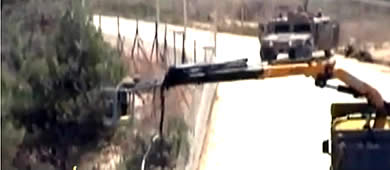
The IDF prunes a tree, providing an excuse for the Lebanese army to attack (Al-Jazeera TV, August 3, 2010). The photograph clearly shows that the pruning equipment is located inside Israeli territory (about 120 meters, or 131 yards, east of the Blue Line). Its arm crosses the security fence into Israeli territory located between the fence and the Blue Line.
The Events of the LAF Attack on Israeli IDF Soldiers
The Lebanese army August 3 attack on IDF soldiers located 120 meters inside Israeli territory may have been a local commander’s decision, but was influenced by the army’s belligerent attitude toward Israel. Hezbollah did not intervene in the incident but publicly sent Israel a deterrent message coupled with an implied warning
Overview
1. On August 3, Lebanese army forces exchanged fire for two hours with an IDF force engaged in tree-pruning activities inside Israeli territory. (UNIFIL determined that the activities were clearly carried out within Israel.) The incident began when the Lebanese army opened fire. An Israeli battalion commander was killed and a company commander was critically wounded. As a result, the incident deteriorated into an exchange of fire lasting about two hours. Three Lebanese soldiers and a civilian were killed and several civilians were wounded (among them a correspondent for Hezbollah’s Al-Manar TV, who was intensively covering the incident).
2. The Lebanese shooting attack on the IDF soldiers was an unequivocal violation of UN Security Council Resolution 1701.[1] So far it is not clear at what level of the Lebanese army the decision was made or the order to shoot was given. In our assessment the Lebanese army’s supreme command is not interested in an outbreak of military hostilities with Israel. However, it can be assumed that even if the order to open fire was not given by the Lebanese supreme military command, it was influenced by the belligerent attitude of the Lebanese army (and its brigades deployed in south Lebanon) toward Israel, an attitude also expressed by the Lebanese media.[2]
3. The Lebanese government represented the attack as motivated by an Israeli violation of its sovereignty. The Syrian government expressed support for Lebanon. Hezbollah strongly denounced what it called the “Zionist crime,” and especially the harm which came to its correspondents, which it represented as “a crime against freedom of expression” (Lebanese News Agency, August 3, 2010).
4. Hezbollah leader Hassan Nasrallah discussed the attack at length in a speech on the eve of the fourth anniversary of the Second Lebanon War. He stressed that Hezbollah had acted with restraint, had not intervened in the incident and had allowed the Lebanese army to conduct the battle alone. However, he added that from now on, wherever the Lebanese army was attacked by Israel and “the forces of the resistance are present,” the resistance will not remain silent and will not restrain itself, but will chop off the Israeli hand raised against the Lebanese army.
5. In his speech, Nasrallah proposed a new equation containing a deterrent message with a the hint of a threat against Israel. He exploited the incident to emphasize the internal Lebanese legitimacy for Hezbollah’s continued existence as an organization with a military infrastructure, which he claimed protected Lebanon and supported its army. Nasrallah described the Lebanese army conduct as “heroic” and claimed that it had “painted with blood” the model of the “people-army-resistance” Hezbollah was trying to promote.
The Events on the Ground
6. At around 12:20 on August 3 a Lebanese army sniper force opened fire on an IDF force performing routine tree- and bush-pruning activities on the other side of the security fence. The activity took place inside Israeli territory, north of the Israeli community of Misgav Am and near the Lebanese village of El Addeise, and did not cross the Blue Line.[3] The Lebanese sniper fire was covered by correspondents present at the site of the attack, including one from Hezbollah’s Al-Manar TV.
7. The Lebanese fire came from one of the buildings in El Addeise. Israeli Lieutenant Colonel (Res.) Dov Harari, battalion commander in the region, was shot in the head and killed. A major (Res.) who commanded a company was shot in the chest and critically wounded. Both officers were on the Israeli side of the border, directing the pruning activities.
8. The IDF force returned fire using light arms, artillery and combat helicopters, attacking Lebanese army posts and the regional battalion headquarters in the village of A-Taibe. Three Lebanese soldiers were killed and a number of Lebanese army armored vehicles were damaged. One IDF artillery shell missed its target and mistakenly wounded a number of civilians, among them media personnel affiliated with Hezbollah (an Al-Akhbar correspondent was killed and an Al-Manar TV correspondent was wounded).
9. While the IDF returned fire, a number of requests were received from the senior command levels of the Lebanese army asking that the firing stop so the Lebanese wounded could be evacuated. The IDF agreed to a cease fire. Half an hour later the Lebanese army fired RPGs at an Israeli tank but missed the target. The tank responded by returning fire at the attackers and the Lebanese post from which the RPGs had been launched. The incident lasted for about two hours.
The site of the attack
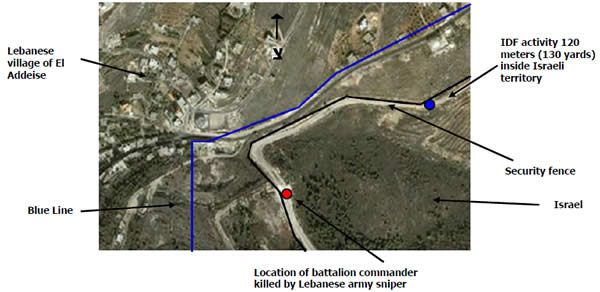
Area of the attack close to the Israeli community of Misgav Am, near the security fence inside Israeli territory.
Previous Lebanese Army Shooting Attacks against the IDF
10. On the night of February 7, 2007, during an IDF activity to uncover IEDs in the area of Maroun el-Ras, apparently planted by Hezbollah operatives, the Lebanese army attacked the force with light weapons and machine guns. In that case, the IDF had crossed the border fence but not the Blue Line, and was operating inside Israeli territory (in the area between the fence and the Line). The IDF force returned fire at the Lebanese army APC, wounding several Lebanese soldiers.
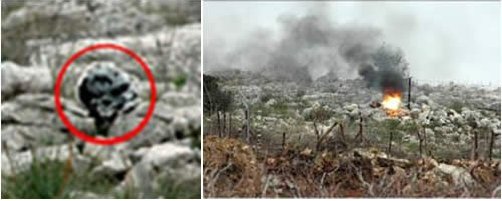
Left: One of the IEDs camouflaged as rocks found in Israel territory in the region between the border fence and the Blue Line (Photo courtesy of the IDF Spokesman). Right: The IDF detonates one of the IEDs (Photo courtesy of the IDF Spokesman).
Israeli Reponses
11. A spokesman for the Israeli foreign ministry said in an announcement that Israel viewed the incident as a grave violation of UN Security Council Resolution 1701. Israel lodged an official complaint with the Secretary General of the United Nations and the Security Council, stating that the current attack was one more in a long series of Lebanese violations of the resolution, the most serious of which was Hezbollah’s armament in south Lebanon (IDF Spokesman, August 3, 2010).
12. Israeli Defense Minister Ehud Barak warned the Lebanese government against continuing such provocations and demanded it investigate to reveal who was behind the incident (a similar message was later sent by the Israeli Prime Minister). He also called on the UNIFIL forces to carry out their mission and duty to investigate the incident, to act with determination to prevent recurrences and to stop the Lebanese army’s provocations along the border with Israel. He also said he expected the international community to condemn the attack (IDF Spokesman, August 3, 2010).
Lebanese Government Response
13. Senior figures in the Lebanese administration denounced Israel, claiming it had invaded Lebanese territory and violated UN Security Council Resolution 1701:
A. Lebanese Prime Minister Sa’ad Hariri, who spoke to the Lebanese president and army commander, condemned Israel for what he represented as “its violation of Lebanese sovereignty” and the wounding of a Lebanese soldier and civilians. He asked the international community to exert pressure on Israel to stop its aggression (Lebanese News Agency, August 3, 2010).
B. Lebanese President Michel Suleiman, briefed on the incident by the commander of the Lebanese army, said that what he called “this penetration” had to be opposed no matter what the results. He communicated with his foreign minister, asking him to contact the international community regarding the incident (Al-Nishra, August 3, 2010).
C. Lebanese Foreign Minister Ali al-Shami asked the ambassadors of the five permanent members of the Security Council and Michael Williams, the UN’s special coordinator in Lebanon, to discuss the events. The Lebanese foreign ministry asked its representative in the UN to call an emergency meeting of the Security Council.
Hezbollah’s Response
14. Hezbollah leader Hassan Nasrallah gave a live speech on the eve of the fourth anniversary of the Second Lebanon War, beginning it by referring at length to the incident. He represented Israel as responsible for continuing “aggression” against Lebanon, and Hezbollah as the force supporting the Lebanese army and defending south Lebanon.
15. In his speech he made the following points (Al-Manar TV, August 3, 2010):
A. Although the war was over, Israeli “aggression” against Lebanon had not stopped, and proof of that was the endless Israeli violations of Lebanese sovereignty [since the end of the Second Lebanon War he has claimed 7,000 such “violations”]. He also claimed that the Security Council did nothing to prevent the violations.
B. Hezbollah forces worked in full cooperation with the Lebanese army. As soon as the incident began Hezbollah forces (“resistance”) in the area were put on alert and followed the events on the ground, but used restraint and allowed the Lebanese army to conduct the battle. The Hezbollah leadership, which was in contact with its commanders in the south, ordered the commanders on the ground to do nothing but wait. (Thus Hassan Nasrallah admitted the deployment of armed Hezbollah forces south of the Litani River.) The Hezbollah commanders contacted Lebanese army headquarters and told them that Hezbollah would not take the initiative in activity in the field but that its forces were available should they be needed.
C. Hezbollah acted with restraint and did not intervene, but from now on, wherever the Lebanese army was attacked by Israel there would be a Hezbollah (“resistance”) presence: “The resistance will not be silent and will not restrain itself, and it will chop of the Israeli hand raised against the Lebanese army…That is a decision for honorable defense and is accepted by every self-respecting [person] in the country…The resistance has the honor of being defended by the army and the resistance defends the army…That is the only equation defending Lebanon and preserving its honor.”

Viewers watch Hassan Nasrallah on a giant screen as he delivers a speech (Nahar.net, August 3, 2010).
16. Hassan Nasrallah repeatedly stated that Hezbollah did not take part in the most recent incident but he used it as a means of legitimizing Hezbollah and send a deterrent message to Israel, accompanied by an implied threat. In our assessment, emphasizing the legitimacy of Hezbollah’s continued existence as an organization with a military infrastructure, defending, according to Nasrallah, Lebanon and supporting its army, is important to the organization. That is true especially in view of the possibility that indictments will be handed down to Hezbollah operatives by the international tribunal investigating the murder of Lebanese Prime Minister Rafiq Hariri. The message, with which Nasrallah has inculcated the internal Lebanese arena for years, is particularly important in view of the internal Lebanese and international criticism of Hezbollah as an armed organization and of the demand of the international community to implement Security Council Resolution 1701.
17. As is customary in such incidents, Hezbollah’s propaganda machine was intensively active, and an Al-Manar TV correspondent was present at the attack and documented the events.
Hizballah’s Al-Manar TV’s Real-Time Documentation of the Incident
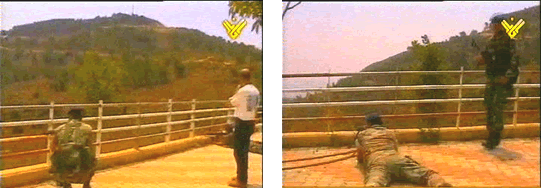
Lebanese soldiers lying in wait for the IDF. Left: A photographer (white shirt) documents the events.
UNIFIL and United Nations Responses
18. Milos Strugar, political advisor to the UNIFIL commander, said that the IDF’s activity were carried out in Israeli territory and that they had been coordinated beforehand with the Lebanese army through UNIFIL. He said that UNIFIL had not yet completed its investigation and that its technical team would measure the distance between the site of the incident and the Blue Line (Interview with Israeli Army Radio, August 4, 2010). Somewhat later, UNIFIL spokesman Naresh Bhat said that the tree [being pruned by the IDF] was on Israeli soil (AP, August 4, 2010). He confirmed that the IDF soldiers were on the Israeli side of the Blue Line (Reuters, August 4, 2010).
19. After the deliberations of the Security Council meeting requested by Lebanese, the Council president, the Russian ambassador, said that its members had expressed deep concern over the incident, which had cost lives on both sides. The Security Council called on Israel and Lebanon to exhibit the maximum amount of restrain to meet their obligations to Resolution 1701 and preserve the ceasefire to prevent further deterioration along the Blue Line. During the discussion the UN Undersecretary did not allow the peace-keeping force to place responsibility on one side or the other, but to make do with a factual report.
Notes:
[1] UN Security Council Resolution 1701 was adopted on August 12, 2006, two days before the end of the Second Lebanon War. It called for a full ceasefire between Israel and Hezbollah, the full disarming of Hezbollah and the cessation of all violent activity against Israel. The resolution also placed full responsibility for all events occurring in Lebanon on the Lebanese government.
[2] For example, Lebanese “military sources” told an Al-Safir correspondent that in the future the Lebanese army would oppose any Israeli violation of the Blue Line. They added “our forces are instructed to open fire automatically without the need for permission from the Lebanese army command, and that is an irreversible decision…” (Al-Safir, August 4, 2010).
[3] The Blue Line is the temporary border determined by the United Nations when Israel withdrew from Lebanon in 2000. It is based on the international border drawn in 1923.



 RSS
RSS


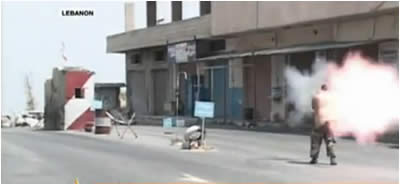
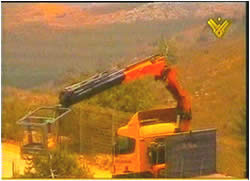
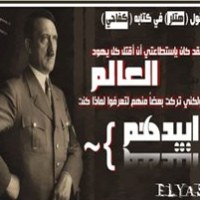
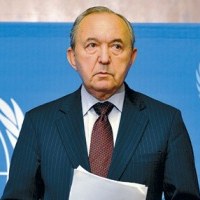

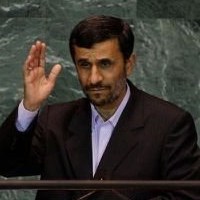
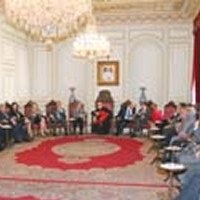




The Events of the LAF Attack on IDF Soldiers #israel #lebanon #idf #laf http://j.mp/dykCAo
RT @CrethiPlethi: The Events of the LAF Attack on IDF Soldiers #israel #lebanon #idf #laf http://j.mp/dykCAo
Israel’s Critical Security Needs for a Viable Peace –
Israel has a critical need for defensible borders. This video outlines the threats to Israel from terrorist rockets, ballistic missiles, and conventional ground and air threats from the east.
http://www.youtube.com/watch?v=ytWmPqY8TE0
For more information visit: http://www.defensibleborders.org/security
-Jerusalem Center for Public Affairs
[…] [1] See the August 10, 2010 post: “The Events of the LAF Attack On IDF Soldiers“. […]